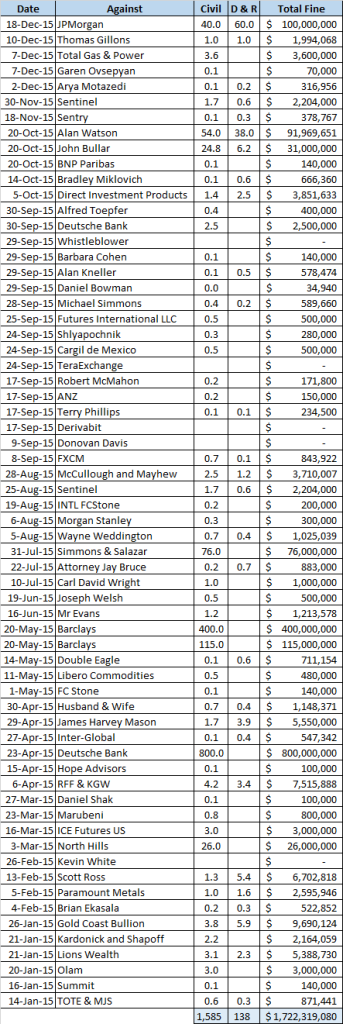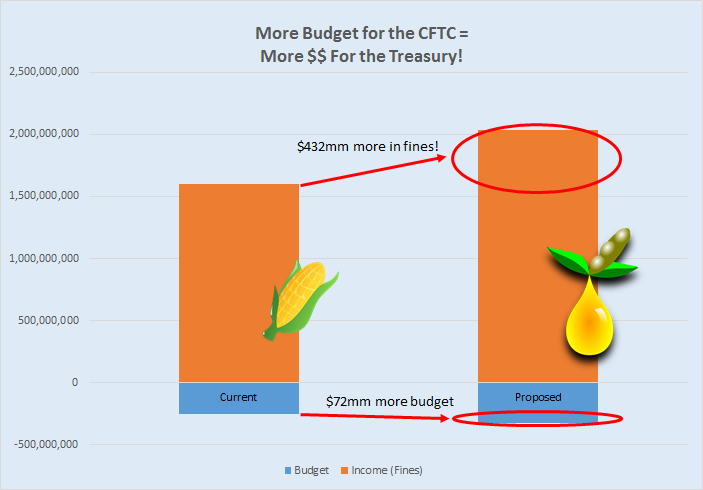aka How to solve the CFTC budget crisis.
Just before the 2015 holidays, the public received word that the CFTC had its 2016 budget set at $250 million dollars, representing no change from the previous year’s budget, and significantly less than the $322m that the Chairman proposed here, and that the President had proposed to Congress.
First, it is interesting to note that the proposed budget is a 98 page pdf. 98 seems like such a suspicious number, as if there is a rule “please keep your answers to under 100 pages”. I wonder if they would have fared better if it was 3 pages. Something like:
 Slide 1: Cover page, complete with photos of happy children eating corn
Slide 1: Cover page, complete with photos of happy children eating corn- Slide 2: An upward-arrow representing an extra $72 million, but this time with more children eating corn. And soybeans. And a couple extra criminals behind bars.
- Slide 3: Large letters “Q&A”
In his request, the extra $72 million that the Chairman asked for seemed well justified, generally revolving around:
- Improved IT across the board
- Enhancing surveillance
- Enhancing enforcement
- All of which in the context of the larger oversight the CFTC has, now that cleared and bilateral swaps are under their realm (and related swaps-stuff like SDs, SEFs, etc)
It’s very similar to what many desk-workers complain of – people keep on piling-on more work with increased obligations, and yet they want it done with the same resources and the same pay. It just doesn’t seem fair.
COMMON SENSE
If you are like me, the first thing you think of when you see that the CFTC budget is $250 million dollars is:
“Hold on, didn’t the CFTC just fine some banks a few bazillion dollars? Where’s the finders fee?”
 So I asked myself just how much revenue the CFTC’s enforcement arm brought in, which led me to this page. I began reading through them and put together a nice summary for you (table on the right).
So I asked myself just how much revenue the CFTC’s enforcement arm brought in, which led me to this page. I began reading through them and put together a nice summary for you (table on the right).
Just one note on my terminology in that table. There is the Civil fine amount (in millions), and then a column I’ve labeled “D&R” (also in millions) which is the combined total of disgorgement and restitution involved in the case. I had invested 10 minutes of my time to try and figure out how disgorgement is different to restitution, but failed. So I just grouped them together. So think of of D&R as “payback”.
WHAT I LEARNED ABOUT CFTC ENFORCEMENTS
If you visit that page, there are probably 80 or so different enforcement actions in the 2015 calendar year. I read through each one, only skipping ahead if it was something I had read before.
The main thing I learned is: There is lots of bad stuff that can get you into trouble. And there is no shortage of criminals doing them.
Some of the recurring themes in these enforcement actions:
- 1 or 2 guys setting up a commodity pool, raising funds and either (a) lying about performance and/or (b) taking customers money and using some of it for themselves.
- Outright Ponzi schemes.
- Lots of schemes that involved customers taking on leveraged gold positions off-exchange. I was previously unaware that leveraged off-exchange metals positions were bad, but can now clearly see it is a major no-no.
- Seems like many of the defendants were based in California and Florida. Maybe the sun has something to do with it.
- Messing with reference rates and fixings is frowned upon, to say it lightly. (LIBOR, ISDAFIX, FX, and there was a commodity one in there too).
- A couple had to do with violating position limits.
- Non-compliance with expclicit reporting requirements. In many cases there was nothing sinister except lack of paperwork.
- A surprising number of them involved telemarketers. Hard to believe people still take calls from telemarketers.
TOP 10 CFTC ENFORCEMENT ACTIONS OF 2015
So, now that I have read all of the enforcement actions for 2015, I thought I’d give you my top 10. Note these are not the top 10 monetary claims, but rather the ones that stood out to me:
- 23-Apr-2015: The 800mm LIBOR fine against Deutsche Bank has to be on the list, simply as it is the largest of 2015. At that time, it represented the 6th firm and a cumulative total of 2.7bn in CFTC fines for LIBOR.
- 16-Jun-2015: A risk consultant (not an employee) at an FCM managed to enter into multiple unauthorized swap transactions for some clients. I just can’t imagine how he managed that, particularly as a consultant. Cost him $1.2mm in fines. He might have been better off just trading swaps on his own account.
- 31-Jul-2015: Couple guys caught running a big Ponzi scheme. Of all the Ponzi schemes this year, this one stood out because they didn’t seem to have any infrastructure whatsoever. The “Black Diamond” trading platform they marketed didn’t even exist.
- 06-Aug-2015: Morgan Stanley fined $300,000 for being under-seg. Which means they didn’t hold enough customer funds, which can put client’s money directly at risk. There were deficits ranging from 5 to 265 million at times. I hadn’t realized this happened this year. Under-seg is fairly taboo within the FCM community.
- 24-Sep-2015: TeraExchange SEF seems to have had their 2 clients “test the pipes” by buying and selling bitcoin NDF’s. Only problem is that wash and pre-arranged trades are not allowed, and they put out a press release and neglected to mention it was pre-arranged. No fine was listed, so perhaps just a slap on the wrist.
- 29-Sep-2015: Not a fine, but rather a whistleblower payout made, in the amount of $290,000. Significant because it is only the 2nd ever CFTC whistleblower payout (first was $240k in 2014).
- 02-Dec-2015: A guy was fined $100,000. The significance here is this is the only “insider information” enforcement I could find, whereas I feel like the SEC issues these on a weekly basis. (Note: I have not researched that.)
- 22-Jul-2015: Attorney Jay Bruce found guilty of aiding and abetting metals frauds. The reason I have him on the list is that with so many frauds on the CFTC list, I had to wonder how they managed to keep them going. The answer: hire a fraudulent attorney to help you.
- 21-Apr-2015. There were many charges brought over the year that have not (at least yet) resulted in fines. (I exclude “charges filed” from my list in the table). But this list would not be complete without mentioning that Navinder Sarao was charged on this day with his alleged involvement with the Flash Crash.
- 06-Apr-2015: One of the many misappropriations of client funds. However this one stood out because one of the benefactors of the misappropriated funds was a dog who received training. So, at least they are responsible criminals. Good dog.
HOW TO SOLVE THE CFTC BUDGET CRISIS
It’s obvious to me that we solve this problem by giving the CFTC a cut of the fines they impose. Isn’t that how everything from Parking Meter attendants to lawyers make a living? You incentivize them to find any wrong-doing.
I will concede that the counter-argument to that logic is you can end up with some ambulance-chasing; but of all of the enforcement actions I read, there didn’t seem to be any that were even borderline frivolous.
Taking calendar year 2015 alone – the CFTC collected civil fines of nearly $1.6 billion. Or put another way, they collected civil fines in excess of 6 times their annual budget. So, for every $1 in budget, they collected $6.
REVISED POWERPOINT
I realize that it would be a heavy lift to have the CFTC collect some of the proceeds from their own enforcement actions. In the US, this would probably require an “Act of Congress”. Note for our foreign readers, this is similar in magnitude to an “Act of God”.
So, conceding that point, I would still propose a 3-page budget proposal. However I would update my second slide accordingly:

Who wouldn’t invest $72 million to make $432 million?
PS
I should note that the CFTC has their own article summarizing their enforcement actions. Difference being they refer to their FISCAL year 2015 (I believe ending Sep 2015).
And they don’t make a clear point about the dog training.
